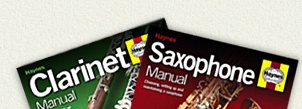Benedikt Eppelsheim bass saxophone
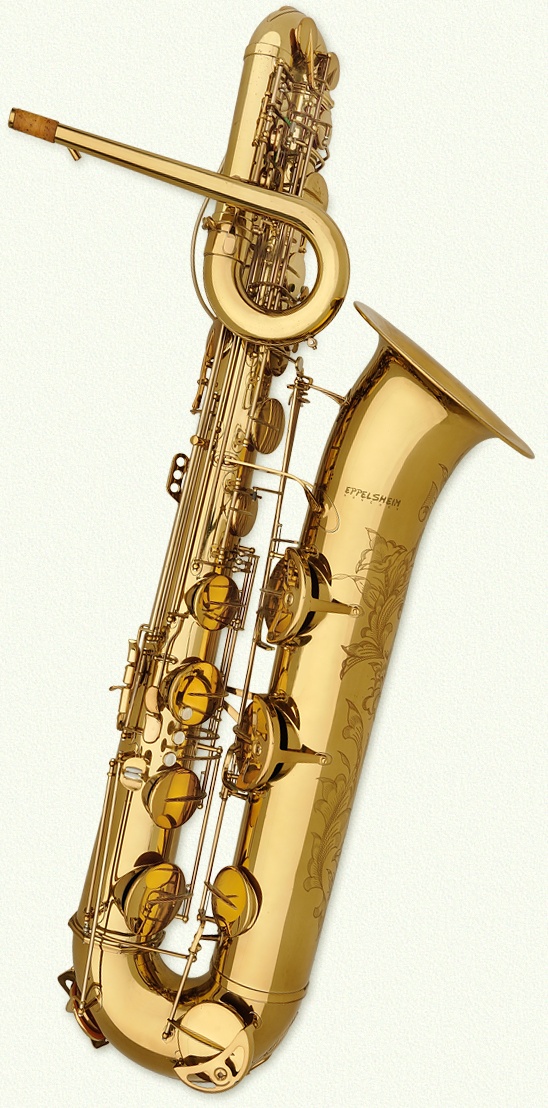 Origin:
Germany Origin:
Germany
Guide price: £20,000
Weight: 9kg
Date of manufacture: 2005
Date reviewed: January 2019
The evolution of the bass
saxophone
When it comes to horns I'm unashamed about my
personal preference for modern examples. Don't get me wrong, I like
a vintage beauty as much as the next player - but in terms of what
I want to feel, hear and live with it's the contemporary
sound that floats my boat.
But not too contemporary, mind - while there's undoubtedly a place
for the sort of tone that's as brittle as glass it's not really
quite my cup of tea. However, when it comes to bass saxes I find
my preferences are somewhat reversed. I say 'somewhat' because it's
slightly complicated.
Y'see, as much as I enjoy the clarity and bite of a modern horn
I'm always mindful of the fact that there's a need to, as it were,
keep one foot in the past. Manufacturers can keep on pushing the
limits of design, but it nearly always comes with a price...and
the price is usually the tone. Stability is improved, playability
is up, tuning is more precise - but every step towards precision
seems to take a horn that little bit further away from the character
of the first horns that rolled off Adolphe Sax's workbench.
In recent years, thankfully, there seems to have
been a recognition that the majority of players are happy to put
up with a few foibles if it means a more characterful playing experience
- and this has led to some exciting new mainstream horns over the
last decade or so.
But the poor old bass seems to have been largely forgotten. It's
easy to understand why; they're hideously expensive and not exactly
what you'd call popular - so there's really not a lot of impetus
to pour shedloads of cash into developing new models.
And this has left the modern bass at something of an impasse - with
preferences (and the market) being very firmly divided between the
vintage and modern cohorts, and nothing inbetween to bridge the
gap.
Is there a gap? Sure there is. You only need to
play a vintage and a modern bass side-by-side to hear the difference
- and it's a far bigger difference than that between a vintage and
a modern tenor or alto.
Granted, a modern bass is undeniably an easier beast to handle -
in fact I'd go so far as to say there's better than half a chance
the thing will actually work properly - but in that push to modernise
it, it seems to me that the very essence of what a bass is has been
rather lost...and I think what we've ended up with is what I call
an 'uber baritone'. Not that there's anything wrong with baritones,
oh no, it's just that the bass should be so much more than simply
a baritone that goes lower.
In other words, it's not just about the low notes - impressive though
they are.
The bass (and sure, this is a very subjective
opinion) should be rich and sonorous. It should have some 'grunt',
so as to lift it out of the mire of vagueness, but not so much that
it loses its identity and its surprising ability to carry a soulful
tune.
Unfortunately it's a great deal easier and cheaper to build a bigger
baritone than it is to come up with a bass that's easy to handle
yet still retains the nimble grace of its forebears.
To do so would take skill and dedication, a sharp eye and a good
ear coupled with the will and ability to think laterally - all of
which perfectly describes Benedikt Eppelsheim, the inventor and
builder of this magnificent instrument.
What makes this bass so very interesting is that
tonal integrity has been placed very high up in the design specifications
- if not at the very top - and thereafter every effort has been
made to make that philosophy pan out in a mechanical sense. It sounds
easy - and on a smaller horn it generally is, but once you get into
the realms of the baritone and beyond you very quickly find that
the sheer size of the necessary keywork may leave you with a horn
that sounds great but feels bloody awful.
This is, essentially, the challenge that vintage bass designers
faced - to which the modern answer was to settle for scaling up
the baritone...at which point the tonal integrity gets shoved ever
further down the list of priorities.
 The
Eppelsheim bass overcomes these limitations with a brave and extraordinary
feat of engineering, as is hopefully evident in the unique design
and layout of the horn. Allow me, as they say, to show you around... The
Eppelsheim bass overcomes these limitations with a brave and extraordinary
feat of engineering, as is hopefully evident in the unique design
and layout of the horn. Allow me, as they say, to show you around...
(* Subsequent to this review being published,
Benedikt Eppeslheim dropped me a line by way of a follow-up on the
technical points raised - and I've added notes where apprpriate
in italics.)
The body tube is in three main sections (plus
the crook), and as per the modern fashion these sections are detachable.
The bell section is held in place by a very substantial flange at
the bottom bow. This is a far, far cry from the usual push-fit joint
with a crude clamp - and it's much more like the sort of thing you
might see on a submarine hatch. It looks like it means business.
There's an identical though obviously smaller flange for the top
bow - situated at the top of the main body tube. I'm pleased to
see it's been placed here rather than at the top of the crook tube,
because it allows for (relatively) easy access to the main body
tube when it needs some dentwork. And on a horn of this size you
can be pretty sure it's going to be a case of when rather than if.
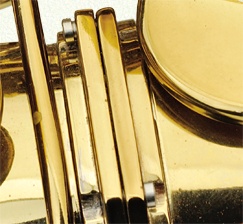 As
per usual, I checked the joint screws - and found that almost all
of them were loose. The lower joint screws weren't too bad (just
needed a little nip up) but some of the top bow screws were well
on their way to falling out (top, right). I suspect a combination
of expansion and contraction, the compressibility of the joint and
the considerable vibrational energy of the instrument are to blame
- though I'm assuming that no-one's taken this horn apart before
and failed to correctly tighten the flanges. As
per usual, I checked the joint screws - and found that almost all
of them were loose. The lower joint screws weren't too bad (just
needed a little nip up) but some of the top bow screws were well
on their way to falling out (top, right). I suspect a combination
of expansion and contraction, the compressibility of the joint and
the considerable vibrational energy of the instrument are to blame
- though I'm assuming that no-one's taken this horn apart before
and failed to correctly tighten the flanges.
Nevertheless, if you own one of these horns it might well be worth
checking the tightness of these screws every once in a while. You
might need to rush out and buy a very long thin-bladed (and thus
flexible) screwdriver though...otherwise you may have to remove
a couple of keys to gain access to that top screw.
* It seems these screws can work their way loose a few months
from new, and may need tightening. Once tightened, however, they
should need no further attention.
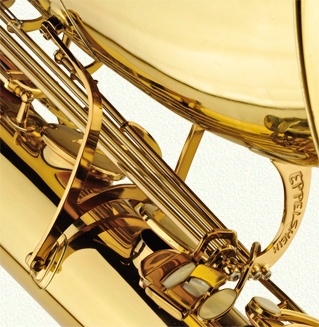 Complementing
the detachable bottom bow joint are not one but two bell-to-body
braces. Complementing
the detachable bottom bow joint are not one but two bell-to-body
braces.
The primary brace has four mounting points and a very unusual 'twisted
H' configuration, while the secondary brace a little lower down
is a relatively simple triple-point affair. Between the pair of
them they offer a very great deal of support to the massive bell,
and such support is very much needed on a horn of this size.
I'm particularly impressed with the primary brace because it spans
(most of) the width of the bell. Bell braces are usually mounted
to the bell dead centre of the tube (and to the side of the body),
which does a good job of supporting the horn in the event of a frontal
knock but doesn't do so well when dealing with side-on knocks. The
H brace has it covered in both planes.
Note the standard tilting bell key table and the curious compound
bell key pillar, which hangs down from the bell. There's a very
good reason for this, which we'll come to a little later...
The top end is equally well supported, with this
nifty brace that sits just above the crook joint.
Take a close look at its design, there's a lot more going on than
might initially meet the eye. Most top bow braces are relatively
simple affairs - little more than a piece of brass bar, or even
just a plate. If a manufacturer wanted to increase the strength
of the brace it's a fair bet that the most they'd do is increase
the thickness of the metal. This would add some stiffness, to be
sure, but it's not really a very elegant solution.
 The
Eppelsheim's brace is not only hewn from a thick piece of brass,
it also features an L-shaped section. This makes the brace rather
stiffer than the mere thickness of the metal, and does so without
appreciably increasing its weight. It's a lot of fuss and expense
to go to, and yet the L-section has been beautifully incorporated
into the curves on the brace. This is superb attention to detail,
and yet I bet hardly anyone gives it a second glance. The
Eppelsheim's brace is not only hewn from a thick piece of brass,
it also features an L-shaped section. This makes the brace rather
stiffer than the mere thickness of the metal, and does so without
appreciably increasing its weight. It's a lot of fuss and expense
to go to, and yet the L-section has been beautifully incorporated
into the curves on the brace. This is superb attention to detail,
and yet I bet hardly anyone gives it a second glance.
The horn is of single pillar (post to body) construction,
with each pillar having a reassuringly large base. A few saddles
have been used here and there, for the side keys and assorted linkages.
The toneholes are all plain drawn and completely level - and are
clearly levelled (or at least dressed) after lacquering. This too
is reassuring, because it means that any stresses induced by the
polishing and lacquering process that may lead to slight warps in
the toneholes can be addressed. And some of the toneholes are truly
massive, given that the largest key cup on the horn clocks in at
around 95mm O/D.
 As
you might expect, the horn comes with all the mod cons. There's
an adjustable thumb hook (metal, of course), adjustable bell key
bumper felts, a large mother-of-pearl thumb rest (a particularly
nice feature) and a very heavy-duty triple sling ring. This is an
especially useful feature which allows you to alter the balance
of the horn depending on your playing position - whether that be
sitting, standing with the horn to the side or with it slung across
your front. As
you might expect, the horn comes with all the mod cons. There's
an adjustable thumb hook (metal, of course), adjustable bell key
bumper felts, a large mother-of-pearl thumb rest (a particularly
nice feature) and a very heavy-duty triple sling ring. This is an
especially useful feature which allows you to alter the balance
of the horn depending on your playing position - whether that be
sitting, standing with the horn to the side or with it slung across
your front.
And then there's the crook, which is both distinctive
and elegant. Basses tend to come in one of two varieties; vintage
style, with a long down-tube running down from the top of the horn
to the crook socket - and modern (Selmer) style, which has a shorter
down-tube that partially doubles back on itself. Both types use
quite short crooks.
The Eppelsheim crook is much larger and longer and has a number
of mechanical advantages. For a start it reduces the amount of 'static
pipework' on the body, which makes for easier access to the keywork
and requires less bracing. It also means that the crook tenon joint
is very much larger than usual, which means it's less likely to
wear or get damaged - and I'd suggest that increasing the distance
between the mouthpiece and the tenon joint is likely to have some
tonal/stability benefits. It also makes it a great deal easier to
keep this section of the horn clean, as it's where all the gunk
tends to settle.
*It also has the advantage that this acoustically critical part
of the horn (from the tip of the crook to the first tonehole), which
often suffers damage, can be completely replaced with ease in the
event of an accident. This would be a far greater challenge on a
standard bass saxophone.
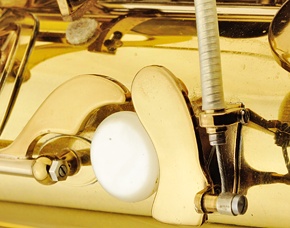 But
what's that little tube sticking out from just behind the mouthpiece
cork? Ah, well, that's the altissimo octave key vent. Yep, this
bass has a dedicated altissimo key. The normal range of the bass
is Bb 3 to F# 6, and this key adds notes all the way up to D 7. But
what's that little tube sticking out from just behind the mouthpiece
cork? Ah, well, that's the altissimo octave key vent. Yep, this
bass has a dedicated altissimo key. The normal range of the bass
is Bb 3 to F# 6, and this key adds notes all the way up to D 7.
Putting a vent so close to the tip of a crook on any horn would
necessitate a very complex arrangement of keys which, on a horn
as large as the bass, would be completely impractical - but the
Eppelsheim uses an ingenious solution to overcome this obvious problem.
The mechanism is driven by a flexible cable, just like the sort
of thing that operates the brakes on a bicycle.
If you're thinking ahead you might be wondering how such a system
can work, given that the crook is now connected to the body via
a cable. Surely this is going to cause a few problems when you want
to remove the crook? Well, the answer is that the cable is in two
sections; there's a fixed portion that runs from the altissimo thumb
key to a lug on the down tube (you can see the cable on the opening
shot) and a detachable section that screws into this lug and runs
up to the vent on the crook (I'd like to have shown this but the
owner seems to have mislaid the cable).
* In fact the owner hasn't mislaid a secondary cable - the lug
on the down tube is actually the spot where you park the cable when
not in use. To use the altissimo function you simply unscrew the
cable from the parking lug and connect it to the vent. Superb!
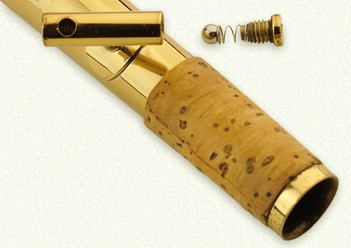 But it gets even better because the altissimo pip features a self-sealing
mechanism, which means that if you can't be bothered with the high
notes or you simply can't be arsed to fit the connecting cable each
time you assemble the horn, you can simply leave it off...and the
pip won't leak. How brilliant is that? However, if you've ever dabbled
with gardening you'll be all-too-familiar with the problems that
can arise from using self-sealing hose couplings - so I decided
to check just how well the pip was sealing. And it wasn't.
But it gets even better because the altissimo pip features a self-sealing
mechanism, which means that if you can't be bothered with the high
notes or you simply can't be arsed to fit the connecting cable each
time you assemble the horn, you can simply leave it off...and the
pip won't leak. How brilliant is that? However, if you've ever dabbled
with gardening you'll be all-too-familiar with the problems that
can arise from using self-sealing hose couplings - so I decided
to check just how well the pip was sealing. And it wasn't.
To be fair it wasn't leaking much - but any leak
on a horn is as welcome as a raincloud at a barbecue, and the nearer
to the top of the horn it is, the greater its effect will be.
So I took the pip apart and found that the seal is provided by a
spring which pushes a ballbearing over the vent hole. The inner
core of the flexible cable rests against this ball, and when the
altissimo key is pressed it pushes the ball back against the pressure
of the spring and opens the vent - and the air escapes from that
hole on the top. Having spent the last 40+ years clearing out the
gunk that you lot blow into your crooks, I kinda figured that such
a precise mechanism isn't going to cope all that well with dirt
and gunge...so I gave it a good clean out and lubed it up with a
drop of mineral oil.
That sorted it, I'm pleased to say - but I'd consider cleaning and
lubricating this gadget as a pretty important piece of regular maintenance.
Fortunately it's very easy to do, and I wouldn't be at all surprised
if mention of it is made in some sort of owner's manual. There's
a small o-ring beneath the head of the screw, and I'd advise smearing
it with a little silicone grease before reassembly.
*Some leakage had been noted from this vent, but it will self
seal again once the valve gets wet (or if kept oiled). The valve
has been redesigned to take a precision rubber ball, and this can
be retrofitted to models with the metal ball.
It's surely clear by now that the design of the
body is worthy of admiration - as is the precise and tidy way in
which it's put together - but it almost pales in comparison to the
keywork.
There's certainly plenty to talk about, but without doubt the most
interesting feature is the use of connecting rods to replace what
would have been rather ungainly key arms. There's no question about
it, it's a brilliant idea, and one that has allowed the Eppelsheim
to throw off the shackles of traditional design and allow for far
more flexibility when it comes to tonehole placement. This is the
horn's killer feature - it isn't limited by the constraints of traditional
keywork...although great care has been taken to ensure that the
horn feels just like any other large sax, at least in terms of general
key placement.
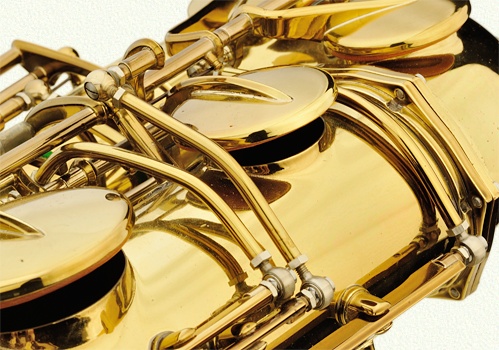 In
order to transmit motion from one end of a key to the other you
either have to use a key built as a single piece (such as your top
D key), or divide the key up into two or more parts. The bit you
press becomes the lever, and this in turn operates a separate key
cup (such as the side Bb on most horns). In some cases an additional
key is required to bridge the gap between the two - and a typical
example of this would be the front top F key which, on some horns,
comprises the touchpiece, an intermediary lever and the top F key
itself. In
order to transmit motion from one end of a key to the other you
either have to use a key built as a single piece (such as your top
D key), or divide the key up into two or more parts. The bit you
press becomes the lever, and this in turn operates a separate key
cup (such as the side Bb on most horns). In some cases an additional
key is required to bridge the gap between the two - and a typical
example of this would be the front top F key which, on some horns,
comprises the touchpiece, an intermediary lever and the top F key
itself.
This system works well enough, but the larger a horn gets the less
well it works. Each connection adds the prospect of play (or lost
motion), it adds weight and complexity and it reduces the responsiveness
of the action. It's still better than single piece keys on a large
horn though, which tend to be cumbersome, unresponsive and prone
to rapid wear...which pretty soon rules out any notion of precision.
This bass does away with such limitations and
makes extended and/or complex links with the aid of connecting rods
that pivot on each end via the use of tiny ball joints. These are
identical to the sort of joints you'll find on your car (the track
rod ends being a particularly good example) - they're just smaller.
There are lots of advantages to this system, the chief of which
is that it allows the keys to be designed to work with maximum efficiency.
Your only fixed placement points are going to be the touchpiece
and the key cup - anything inbetween is largely negotiable, within
limits of course.
There's also very little chance of lost motion creeping in the mechanism
over time because there are no corks or felts to wear down. I suppose
it's possible that the ball joint will wear eventually - but with
such low-torque use I'd expect them to last for a very, very long
time indeed. And if they do wear it's just a simple matter of unscrewing
and replacing them. I wouldn't even mind betting they can be serviced.
It's obviously a very effective system and a cunning
solution to a tricky problem. You've only got to look at the placement
of the low C key cup (in the main shot) to see that it's situated
more or less where you'd expect the low C# cup to be. Now look at
where the low C touchpiece is, and imagine trying to span that distance
with a single-piece key. Sure, it can be done...but you can bet
it'd feel awfully heavy and clunky.
There are, naturally, a few drawbacks. From your perspective it'll
be the cost. I doubt it's an especially cheap way of making keys,
and that's going to be reflected in the purchase price. From my
perspective (and thus ultimately yours too when it comes to paying
servicing bills) it adds extra time to the process of removing and
refitting keys. I suppose, too, that there's always the spectre
of damage - but then again those ball joints have a degree of latitude
built in and should readily accomodate a little bit of misalignment.
All things considered, I really wouldn't be overly concerned with
such drawbacks.
*In fact the connecting rods aren't a new idea - they're pretty
much standard on brasswinds with rotary valves, and have been for
quite some time. So while their use on instruments isn't unique,
I still feel that much credit is due for making use of them on this
horn.
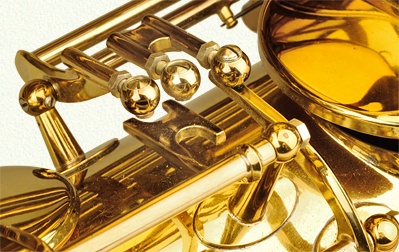 Adjusters!
You want 'em? You got 'em! Adjusters!
You want 'em? You got 'em!
I'm always moaning about horns that don't at least have regulation
adjusters, and on large horns I consider them to be pretty much
essential when it comes to dealing with the inevitable key flex
that comes with large keys. As much as we repairers like to bang
on (at length) about precision, the fact remains that a horn's action
is really quite a crude bit of machinery. There's always going to
be a need for compromises to be made, and the best way to achieve
them is by the use of screws that can adjust the action on the fly,
rather than having to faff around with bits of cork. So I was very
pleased - and relieved - to see regulation adjusters on both of
the main stacks. But it gets better, because some thought has clearly
gone into dealing with the problems of key flex on the lower stack.
Here are the Bis Bb/G# adjusters, and straightaway you can see that
there are three adjusters rather than the normal two. This is because
there's a separate G# adjuster for the low F and E keys - which
are situated above that H-shaped plate.
This makes a considerable difference when it
comes to setting up the lower stack. In the normal course of events
you'd set the G# adjuster to keep the G# key cup closed when playing
an F (whilst also holding the G# touchpiece down). No problems there.
But you also have to set the adjuster so that it works when playing
an F# - and because you're now dealing with a longer stretch of
keywork it's quite likely that the adjustment you made for the F
isn't going to be enough for the F#.
So you tend to split the difference - the amount of which will depend
on various factors such as the flexibity of the keywork, the tightness
of the action and the state of the pads. And when all that's done
you still have to worry about what happens when you want to play
an E...because your regulation setting for the F# may well interfere
with the full closure on the pad.
And so it becomes an exercise in dialling in
an appropriate amount of compromise. In other words there's always
going to be some key flex, so you set the adjusters to distribute
it as evenly as possible across the combined mechanism. The extra
adjuster removes that limitation and allows for a much more precise
setting - and when combined with the regulation adjusters on the
Aux. F bar it gives you so much more control over this pernicious
problem. Better still, there's no connection from the low D to the
Aux.F key, which removes yet another typically problematic area.
And I particularly like the way the adjuster have been fitted to
the key arms. They're threaded on (and thus are replaceable) and
secured with a locknut. It offers a small degree of adjustability
by virtue of being able to move the adjusters in or out, but best
of all it's an aesthetic fit with the ball joints and point screw
lock nuts. There's a similar adjuster on the top stack that deals
with the regulation between the A and Bis Bb keys.
While we're here, take a close look at the stack pillar (centre,
left) - note the small grub screw fitted in the centre. This is
to lock the rod screw in place - and there's another one on the
top stack rod screw. It's there to prevent the rod screw from working
its way out. It's not a terribly common problem, but it does happen
from time-to-time - usually when there's some misalignment within
the key stack. With keys of this size it's highly likely that the
stack is prone to 'temporary misalignment' due to flexing, and that
grub screw ensures that it won't lead to further problems.
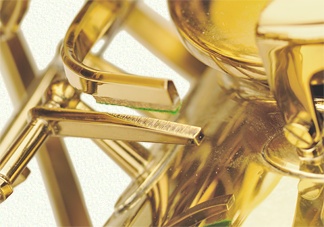 But
given the horn's generosity when it comes to adjusters, I can't
help but wonder why they weren't fitted to the low B and Bb keys. But
given the horn's generosity when it comes to adjusters, I can't
help but wonder why they weren't fitted to the low B and Bb keys.
There's an arm extending off each key that contacts a similar arm
on the next key down. Thus the Bb arm helps to bring the low B cup
down (along with the usual 'tab' beneath the Bb touchpiece) and
the B arm keeps the low C# closed if you're a bit cackhanded over
the bell key table.
And in order to set the regulation between the arms there was just
a big lump of cork.
Given that steps have been taken elsewhere to
mitigate the effect of key flex, I'd have thought that the two largest
keys on the instrument would have been prime candidates for adjusters
- especially as it's here where the compromises can be really punishing.
Perhaps there was an argument to be made for going for as much contact
area as possible rather than only on a distinct point, or maybe
it was felt that there was too much flex to make adjusters worthwhile?
Incidentally, you'll note that the buffer has a layer of felt fitted
to it. Much use has been made of composite cork throughout the action,
and while it's good stuff (very resistant to compression) it does
tend to lag behind in terms of noise dampening. Most of the horn's
action is surprisingly quiet for its size, which is why a handful
of keys made noticeably more noise than the rest. In each case it
was down to composite cork being used as a buffer between another
key or directly against the body - and the very simple solution
was to replace the corks with a layer of felt (it's actually baize)
or a cork/felt sandwich. It made a significant difference.
* Bell key adjusters were fitted to a few of the early Tubax
horns (and if you don't know what a Tubax is, go have a Google),
but the problem turned out to be more of a need to dampen key vibrations
rather than one of precision. Thus the elongated buffers were found
to be a better bet.
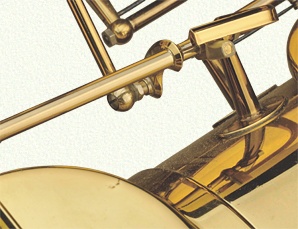 While
we're here - any ideas what this is? While
we're here - any ideas what this is?
It's a link between the low C# key cup and the low C - but what
does it do? In this position both keys are at rest - which means
the low C# is closed and the C is open.
If you press the low C down, the lower of the two arms drops down
- and if you then press the C# key, the upper of the two arms rises.
In other words there's no working interaction between them. At all.
I thought about it...and then thought about it a bit more - and
then I wondered if it might be some sort of inscrutable feature
that only vastly experienced bass sax players would be aware of
(so that's me out then). The best that I can come up with is that
it's a device to minimise key bounce on the low C cup...but it doesn't
seem to be all that effective, or even required.
It just looks a bit...odd.
Answers on a postcard...
*Benedikt did indeed drop me an answer on a postcard, and I was
right...it is an inscrutable feature - and I quote; "The little
arm on top of the low C key is supposed to lift the low C# key up
by one or two millimetres to avoid a secondary resonance in the
closed bore portion around the low C# key. You can try this on any
saxophone; low and middle d and e will respond more clearly and
sound less muffled when the low C# key is open - a small leak is
enough". By the time the bass got to me, someone had already
adjusted this feature out - which is why it made no sense, though
I have to admit that without knowing what it was for, I probably
would have done exactly the same. So now we know.
 And
now it's time to talk about the point screws (you just knew I would). And
now it's time to talk about the point screws (you just knew I would).
They're of the shoulderless type with proper tapered points on them.
Because they don't have a head on them they need some other means
of ensuring they don't work loose, and on modern horns that use
this type of screw (student Yamahas, for example) this function
is achieved by the use of a threadlocking fluid or nylon inserts
fitted through the threaded portion of the screws. However, where
these type of screws were used on vintage horns the most common
method of locking them in place was with a nut - as typically seen
on some King saxes. This is the method that's used on this bass.
I've never been particularly keen on it, and said as much to Benedikt
when I met him at the Frankfurt Musik Messe some years ago. My beef
was that it's a fiddly system to adjust, there's a temptation to
use a pair of pliers to grip the nuts rather than a proper spanner
(thus chewing up the nuts), it takes two tools instead of one to
tweak the action...and there's always a tendency for the nut to
turn the screw just before it locks, which throws out your careful
adjustments and requires you to anticipate how much further the
screw will be driven into the pillar before the nut locks it in
place - even if you use a screwdriver to try to keep the screw in
position. And there are neater solutions these days.
Benedikt disagreed, as well he might, and while I still maintain
it's a fiddly solution I can't deny that his implementation of it
is excellent. Steel (stainless?) nuts have been used, which'll take
a lot more punishment than brass ones - and the point on the screws
is a large as can fit through the pillar. In short, you have more
than a lifetime's worth of adjustment built in - and I can't complain
about that.
 Which
is why I smiled wryly to myself as I set to adjusting out a spot
of free play on the side Bb lever key and found a little gotcha. Which
is why I smiled wryly to myself as I set to adjusting out a spot
of free play on the side Bb lever key and found a little gotcha.
This sits at the bottom of a triple-headed pillar (above), with
the side C lever above it and the top E above that. With three screws
in such close proximity it proved to be impossible to fit a spanner
over anything other than the uppermost nut (the top E) because the
other nuts are in the way. In order the adjust the side Bb I had
to remove the side C screw...and in order to remove that I had to
remove the top E screw.
I told you it was fiddly...
I got very fed up with it very quickly indeed and decided the best
course of action would be to knock up a special tool that would
speed up the process and allow me to adjust a single screw within
a group without having to remove the adjacent ones. It's just a
small hex socket that's been cut in half, tidied up a bit and fitted
with a handle. It works an absolute treat, though some care must
be taken to choose a socket with a thin enough wall so as not to
foul on an adjacent nut. But taking it all into consideration I
feel I ended up coming round to Benedikt's point of view. It's not
the most elegant solution, but it provides a great deal of adjustability
on a horn that's likely to suffer quite a few knocks - and takes
into account the fact that access to some pillars (should they require
reaming, for example) may be limited. As such I have to admit that
it works perfectly for this horn - though I will temper my retraction
by saying it's still a poxy idea on smaller horns, and that there's
another gotcha in the shape of access to the Bis Bb upper screw
being blocked by the top bow stay. Let us never speak of it again.
One of the reasons this horn came in for a service
was that there was some difficulty in getting the low notes. A quick
examination revealed that the compound bell key pillar had taken
a knock backwards, and there was now a considerable amount of free
play on the bell keys.
I see this sort of damage on a regular basis, and when it comes
to running up a review I'm never too slow to point out what I feel
to be weak engineering in this area. Let's face it, horns are relatively
fragile and sax players can be rather clumsy (or 'overenthusiastic',
if you like) - and you'd be surprised at how little a knock is required
to push this pillar out of whack. If that happens just before you're
about to go on stage, it's gig over for you matey.
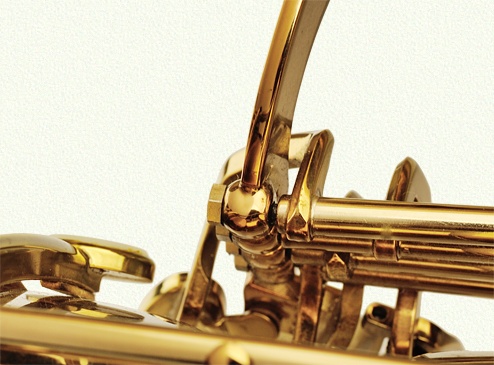 So
there I was staring at Benedikt's compound bell key pillar. It's
a very unusual arrangement, because rather than being fixed to the
body it actually drops down from the bell. It looks like it ought
to be quite sturdy, what with the thickness of the metal, the substantial
base and the supporting rib to the rear of the pillar - but in fact
it's surprisingly flexible, and it really doesn't take much effort
to make it move (just a firm push with a finger was all it took
to shift it momentarily). On any other horn I'd flag this up as
a major problem - a very major problem - but to do so on this horn
would be to overlook a very cunning feature. So
there I was staring at Benedikt's compound bell key pillar. It's
a very unusual arrangement, because rather than being fixed to the
body it actually drops down from the bell. It looks like it ought
to be quite sturdy, what with the thickness of the metal, the substantial
base and the supporting rib to the rear of the pillar - but in fact
it's surprisingly flexible, and it really doesn't take much effort
to make it move (just a firm push with a finger was all it took
to shift it momentarily). On any other horn I'd flag this up as
a major problem - a very major problem - but to do so on this horn
would be to overlook a very cunning feature.
Y'see - I'm always banging on about how vulnerable large horns are
to knocks and bashes. The sheer size and weight of anything larger
than a tenor makes it a liability, and it's usually the bell that
takes the brunt of the damage - and as any bari/bass player who's
ever knocked a bell will attest, it typically means the low notes
are dead in the water. And any such player who can't get any low
notes is going to find themselves surplus to requirements in no
time at all.
But (and this is really clever) the bass is designed so that the
entire bell key action is mounted on the bell section. Yep, the
whole lot. This means that the horn has a degree of knock tolerance
built in. If the bell moves, the keys move with it - and the pad
to tonehole relationship is maintained. For sure, if you dropped
the horn from standing height the lack of low notes is going to
be the least of your worries - but for the typical workaday knocks
that big horns are susceptible to, the design makes complete sense.
OK, I still feel that pillar could benefit from being a tad stiffer
but in all honesty I can't really mark it down when considering
the bell key mechanism as a whole - and given the sheer amount of
engineering thought that's gone into this horn I really wouldn't
like to bet that the flexibility of this pillar is actually a design
feature. Let's just say the jury's out on this one.
*There was an issue with flexing on this pillar,
but rather than the pillar itself flexing it was down to the wall
of the bell. A long, angled brace was subsequently fitted such that
the base of the pillar, the pillar itself and the new brace form
a triangle - which is an extremely stable design.
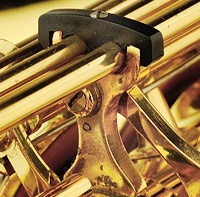 So
far the horn's done pretty well, but I do have a couple of minor
grumbles. So
far the horn's done pretty well, but I do have a couple of minor
grumbles.
The first is the ridiculously small nut that secures the bell key
barrel anti-flex brace in place. You know the sort of thing, you've
probably got one fitted to the side top E and F# barrels - about
halfway along the keys, adjacent to the A key. Unfortunately I was
so busy cursing the damn thing that I forgot to take a photo of
it, so here's a shot of one on a Yanagisawa alto.
The one on the bass is of a similar design, except that there's
a thread that runs right through it and it's fixed onto the supporting
pillar by means of quite possibly the tiniest nut you've ever seen.
And to make matters worse there's barely a millimetre of thread
sticking up out of the brace. So you're trying to hold the fiddly
small brace in place while you try to thread the world's smallest
nut onto the world's shortest thread. Oh, it was fun.
There really was no need to make it so damn fiddly. The thread could
have been larger, it could have been longer - and the hex nut could
have been replaced with a cylindrical knurled nut...or even just
a larger bloody nut.
*Benedikt reassures me that should anyone be unfortunate enough
to lose this fiddly nut, he'll be more than happy to send them a
replacement - for free, worldwide. This is a comfort, I'll agree
- but it still doesn't make the thing any easier to fit.
My other grumble is a little more worthy, because
I noticed that all of the palm key touchpieces and both of the side
key cups had considerable play in the pivots.
I'd like to be able to say that it was down to fair wear and tear,
but the extent of the play didn't match any of the play on the rest
of the horn (which was minor at best).
 All
of the affected keys required quite a lot of swedging to bring them
down to size, and to make them fit snugly between their pillars.
As it's a horn with quite a few bars under its belt (I don't yet
know how old it is... I'm currently waiting for that information
to come through. *Benedikt says it dates from 2005.) I feel
it's only fair to give the benefit of the doubt, but as I spend
most of my days addressing such wear I like to think I have a pretty
good idea of what constitutes wear and what looks like a build quality
issue. So I'm a bit 'Hmmm' about this one. All
of the affected keys required quite a lot of swedging to bring them
down to size, and to make them fit snugly between their pillars.
As it's a horn with quite a few bars under its belt (I don't yet
know how old it is... I'm currently waiting for that information
to come through. *Benedikt says it dates from 2005.) I feel
it's only fair to give the benefit of the doubt, but as I spend
most of my days addressing such wear I like to think I have a pretty
good idea of what constitutes wear and what looks like a build quality
issue. So I'm a bit 'Hmmm' about this one.
Anyway, here's a fancy animated gif of the play on the side Bb key
to look at - see what you think.
*This issue was noted on later models and was corrected by decreasing
the size of the reamer used to set the diameter of the bore in the
key barrels.
On the plus side, in spite of the swedging required
to correct the play, the lacquer on the keys remained unmarked -
and given the condition of the rest of the horn I think it's fair
to say it looks to be pretty tough stuff.
The octave key mechanism, despite being truly
vast in size, is nonetheless just your basic swivelling mech. And
there's really no need for it to be anything else.
There's some added complexity by way of the ball-jointed link from
the thumb key and the extended arm for the body key, but it makes
no difference to the standard operation of the mech. There's really
not a lot to say about it other than it's very well made and as
slick in action as you'd hope it to be.
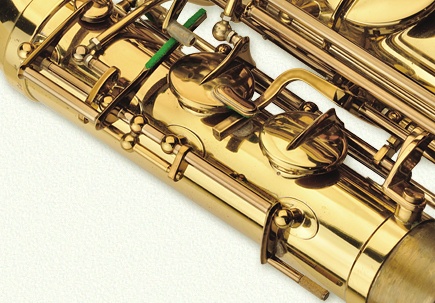 You
can see some of the vast crook tenon sleeve on the bottom right.
The crook joint, though standard, is reversed - with the socketed
portion being fitted to the crook. I mentioned earlier that its
girth would likely mean that it won't suffer from too much wear
- which is just as well given the wall thickness of the tenon sleeve,
because there's just no way you'd ever be able to expand it. You
can see some of the vast crook tenon sleeve on the bottom right.
The crook joint, though standard, is reversed - with the socketed
portion being fitted to the crook. I mentioned earlier that its
girth would likely mean that it won't suffer from too much wear
- which is just as well given the wall thickness of the tenon sleeve,
because there's just no way you'd ever be able to expand it.
Note the felt on the G key arm, which replaced a strip of composite
cork. As mentioned earlier, the noise from this type of cork was
considerable - and in the case of the G key it made it rather inclined
to bounce. A very definite improvement.
*It will be possible to expand the tenon sleeve if needs be as
it's annealed, and therefore standard tools should work on it. To
do so, though, the top tube section will need to be removed. Benedikt
says that this will require around 20 screws to be removed.
Wrapping up the keywork is a full set of flat
mother-of-pearl key touches and rollers, blued steel spring and
a set of Pisoni Pro pads - which were well set, and properly secured
with plenty of hot-melt glue. And I mean plenty.
 The
horn comes with a substantial case. It's of the semi-soft variety,
but still manages to add a hefty 10kg to the already hernia-inducing
9kg of the instrument itself. The
horn comes with a substantial case. It's of the semi-soft variety,
but still manages to add a hefty 10kg to the already hernia-inducing
9kg of the instrument itself.
Unfortunately the photo doesn't really capture the scale of the
thing - it really is unfeasibly large, and wouldn't fit into the
boot of my BMW tourer without having to put the rear seats down
(which is always a bloody nuisance).
Fortunately it just about fitted across the width of the rear seats...but
only just.
Hefting this little lot around will put hairs
on anyone's chest - and after my last experience with a bass I was
half expecting my poor old back to give way and land me in bed for
a few days. I'm pleased to say it didn't, but probably only because
I could only take a few steps at a time before I had to put the
case down and stop for a recuperative cup of tea and a medicinal
bun.
There's a little space inside the case for your
knick-knacks, but the bulk of the storage space is provided by a
large zippered pouch that fits down the bell...a feature than I'm
none too keen on, I have to say. For the size of the pouch it was
remarkably unpopulated, especially as it appeared to have several
distinct compartments within it. Perhaps there was an accessory/tool
kit with it originally? *Yes, there was.
And yes, it's a zippered case...and we all know what I think of
zippered cases...
Picking the horn up to play it is quite an event
- not just because of the sheer size and weight of the thing, but
because it has so much presence. For sure, this is common to all
large instruments - but the Eppelsheim bass seems to come with grandeur
fitted as standard.
If admiring looks are what you're after, this is definitely the
horn for you. Anyone who's unfamiliar with saxes can't fail to be
amazed by this horn, and anyone who knows one end of a sax from
the other will be utterly beguiled by the apparent complexity of
the keywork. It's a genuine show-stopper - and the very best of
it is that you needn't then feel obliged to put on a dazzling display
of technique, you simply have to hit a low Bb and everyone will
gasp in astonishment. Sometimes, just sometimes, it's all too easy.
As far as how the horn feels under the fingers
goes I think it's fair to say that I've played baritones that are
harder to handle. With that said there's an initial sense of it
being somewhat...unnatural.
The thing is, when you've handled as many horns as I have in my
lifetime you sort of build up something of an expectation. Hand
me a Conn 10M or a YAS62 - or a Super 20 alto or a MkVI bari, and
I know what it should feel like even before I've laid a finger on
it. I know the feel of a single key compared to a levered one, I
feel the softness of leverages that aren't optimal, of stacks with
wear in the barrels. Which is why the bass felt strange.
Oh, to be sure, not unpleasant - not at all. In fact quite the opposite.
In fact too opposite. Yes, it's a big horn - so there's a certain
unavoidable unwieldiness to it - but it's like half the equation
is missing. You have the size of the keys, you have the weight...but
you don't have the hesitation that ought to accompany it. It's utterly
delightful.
If and when you experience that moment, savour it - because it won't
last long. Your fingers and your brain will register a moment of
confusion, and then it's pretty much all 'so last week' from the
moment you realise you can really whizz about on this fantastic
beast. Comparatively speaking, of course. Nothing's going to change
the fact that it's a big horn, so if you're expecting the feel of
an alto you're going to be a bit disappointed - and if you were
expecting the feel of a large baritone I think you're equally likely
to be disappointed. It really is, as they say, a whole new ball
game. On the one hand you have those beautifully efficient linkages,
those extra regulation points and an action that's potentially as
tight as it's possible to be - but on the other you have significantly
larger keys down at the lower end...so it all becomes a bit of a
balancing act. But then that's the real beauty of this horn, it's
superbly balanced in every respect.
I had some initial misgivings about the bell key
cluster inasmuch as I felt the low B touchpiece was placed a little
too close to the axis of rotation. It'd have been fine on an alto
or a tenor, but it didn't seem to have enough leverage to handle
the weight of the key. At least on the bench, at any rate. In the
hands it seemed to perk up somewhat, and after half an hour of playing
I found myself wondering what all the fuss had been about. It's
perhaps worth mentioning that some care and attention should be
paid to the spring tension on the bell keys. They're not especially
fussy, but you don't want to stray too far towards the extremes.
Ergonomically-speaking everything's where it should be and it's
very clear that a great deal of effort has gone into keeping the
'keyboard' as compact as possible. In short, there wasn't anything
I tripped up on once my fingers had slipped into 'big horn mode'.
Perhaps the biggest improvement I made to action
(aside from realigning the compound bell key pillar) was fitting
those felt buffers. I wouldn't go so far as to say the horn was
rattly or clunky when it came in, it just that it sometimes got
a bit...percussive in places. Quietening the action and taming some
of the key bounce really improved the responsiveness.
Will it fit your hands? If you're comfortable with a baritone then
I see no reason why the Eppelsheim would cause you any major problems.
The one thing that might prove to be a bit of a stumbling block
though is the weight. It's quite possible to sling this thing around
your neck, and the triple sling ring certainly helps when it comes
to finding the best centre of balance for your personal preference
- but there's no getting away from the fact that it's 9 kilos of
brass and steel.
 It's
not the heaviest bass I've played (that gong goes to the Keilwerth
Special bass, which clocked in around 10kg - though in its defence
it did go down to low A), but at this sort of weight I suspect that
a kilo here and there probably makes no real difference at all. It's
not the heaviest bass I've played (that gong goes to the Keilwerth
Special bass, which clocked in around 10kg - though in its defence
it did go down to low A), but at this sort of weight I suspect that
a kilo here and there probably makes no real difference at all.
Fortunately the Eppelsheim comes with some relief in the form of
a floor spike - the (very) sturdy socket for which can be seen on
the right.
It's fully adjustable with ease and gives you the option of using
the spike in both the standing and sitting positions - and is likely
to become your new best friend in no time at all.
Here's a little tip for new owners though - don't just throw the
spike down the bell when you're done playing. Just below this fitting
there are three outward dents in the bottom bow. They're all within
a couple of centimetres of each other, they're all the same size
and they've all been punched in from inside the bore by something
suspiciously like a floor spike. I find it hard to believe that
anyone would do such a thing, so maybe the spike was placed in the
accessory bag a little carelessly and subsequently fell out...and
it took three goes before the owner figured out what the problem
was?
*There shouldn't have been a need to remove the spike because
the bass will fit into the case with the spike fitted (and retracted,
I should add). On later models the spike was made to be more of
a semi-permanent fixture - only removable with the aid of tools.
And how does it sound?
Glorious. Simply glorious. In the opening blurb I spoke about the
tendency for modern basses to sound rather like oversized baritones,
and from the very first note it becomes patently obvious that this
is a true bass. There isn't that sense of constriction, of feeling
that the money's been spent merely on the pitch of the notes. It's
quality over quantity.
The low notes are impressive, as you might imagine. Granted, this
is true of any bass - but the Eppelsheim is relentless in its ability
to stretch the tone out. It's rich yet punchy, and manages to be
full without tipping into overblown and flabby. It also avoids the
uber-baritone nasality whilst still providing plenty of definition....and
yes, I do believe there's even a bit of glitter thrown in for good
measure.
Tonewise it's an excellent blend between the old and the new, and
yet at the same time it has a very unique quality about it that's
quite hard to describe because there are so few points of reference.
I guess if you've ever played one of Sax's original horns you'd
perhaps understand what that means. The sound it produces is undoubtedly
that of a sax, but it's different. It breathes.
And so will you, because it's really rather easy to blow.
I put a lot of store in what a horn makes me want
to play - and after I'd spent a good while pumping out fat low notes
(well, you would, wouldn't you) and running through the usual raft
of tedious scales and arpeggios, I found myself...well...drifting.
At this point in a playtest I'd usually be veering towards a particular
style - say soul or funk, west coast or blues...or maybe just relaxed
ballads - but this horn had me noodling. It's as though it makes
you play every riff and trick you know just so you can hear how
different it sounds, and then you sort of get a bit lost and end
up wandering around in a kind of comfortable nonchalance. Strollin',
in other words.
I noted no problems with tuning and evenness across
the range (I wasn't able to try the altissimo register) other than
the usual foibles you get with any unfamiliar horn. For example,
the middle D started off quite stuffy but rapidly opened out after
half an hour or so. It's all about finding the core of the note
and locking the embouchure in on it. All standard stuff.
Now, I should put those remarks into perspective
by saying that I'm by no means an expert when it comes to playing
the bass.
Sure, I've long since cut my teeth playing baritone - vintage and
modern - but the bass, like the soprano, is somewhat distinct from
the standard alto/tenor/baritone trio insomuch as it requires a
bit more thought than simply approaching it as just a large member
of the family. There's...how shall I say...a different emphasis
to the notes. If you just pick the horn up and blow it, it'll play
just fine - but to get the best out of it, and to really appreciate
just how subtle and lyrical a true bass can be, you need to spend
some time with it...and certainly more time than I had.
You choice of mouthpiece is going to be important. The bore on this
horn is cavernous for a start, and it'd be daft to whack a high-baffled
screamer on it and expect to get tonal value for money. It came
in with a Zinner, which suited the horn perfectly. Your mileage
will vary, of course.
 Naturally,
it's an extremely expensive bit of kit - but what about the competition? Naturally,
it's an extremely expensive bit of kit - but what about the competition?
There isn't much really. There's the Selmer at around £23k
and the Keilwerth at £18k. They're both good horns - but they're
also very much modern basses. If you want a bass with more presence
you'll have to go vintage, or you can take your chances on one of
the cheap(er) Chinese
basses that are modelled on the vintage design. Best of luck
with that.
I'm sure many a vintage bass fan would make a good case for buying
one over a modern bass, but they're not without their issues - and
I'm working on the basis that you have twenty grand plus to throw
at a bass and don't want to end up with a clunky old war-horse.
So just get the Eppelsheim. It's handbuilt, beautifully designed
and put together...and arguably blows anything else clean off the
stage. Effortlessly.
And as you'll have seen from the additional italicised
comments added subsequent to my publishing this review, the builder
cared enough about his creation to take the time and trouble to
respond to the points I raised - and better still (and more importantly)
to have spotted and dealt with any issues as part of an ongoing
desire to develop and perfect his designs. Such pride and care is
a rare thing in this industry - where you typically have to hand
over your money and hope for the best.
So how shall I sum up this horn?
I would very much like to remain cool and professional - to carefully
weigh the pros and cons, to shape 40 years of experience at the
workbench into a cohesive and structured report. But I can't...I
just can't.
It is, quite frankly, a tour-de-force. I know it, you know it -
and I know Benedikt knows it. If you've ever had the pleasure of
meeting the man you'll recognise his personality in this horn. It's
precise, it's measured, it's efficient - but it's also characterful
and yes, maybe even slightly quirky in a thoroughly charming way.
But more than this it represents a vision, a quest for the kind
of perfection that keeps the spirit of tonality at its heart, and
one that tempers the glint of the present with the soft glow of
the past.
It's a remarkable achievement in every respect, and I rather feel
that although Adolphe Sax might well be amazed at how things have
developed since his first horns rolled off the workbench - this
horn, perhaps above all others, would make him smile.
And I'm sure he'd just nod - because nothing would need to be said.
|

